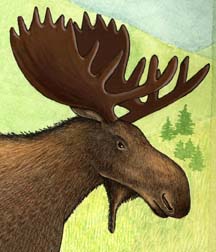

Moose are found throughout northern North America, in Europe, and Asia. In North America they can be found throughout Alaska, Canada, Northeastern United States, and the Rocky Mountains in Colorado. They are also in northern Europe and through Siberia and Mongolia.
Moose live in cooler, northern boreal forests. They do not do well in temperatures higher than 80° F. They are usually found near or in lakes, ponds, and swamps.
Moose are the largest members of the deer family at up to 10 feet long. Males are larger than females, weighing up to 1,400 pounds and having antlers that can be 6 feet wide. They are the largest antlers in the world. Like all deer, they lose them in the spring and re-grow them again.
Moose are active all day (diurnal), but most active at dawn and dusk. They are good swimmers and fast runners. Adults can run 35mph.
Moose eat the twigs, bark, roots of willows and aspens, conifer needles and water plants. Moose live alone and spend most of their time eating.
Predators are bears, wolves, and man.
Females are pregnant for 8 months (gestation) all giving birth in late May and early June to one young, though twins are common.
They can live 20 years in the wild. Few live more than 12 years. They are not a threatened species.
Kingdom: Animalia
Phylum: Chordata
Subphylum: Vertebrata
Class: Mammalia
Order: Artiodactyla
Family: Cervidae
Subfamily: Capreolinae
Genus: Alces
Species: Alces alces
When you research information you must cite the reference. Citing for websites is different from citing from books, magazines and periodicals. The style of citing shown here is from the MLA Style Citations (Modern Language Association).
When citing a WEBSITE the general format is as follows.
Author Last Name, First Name(s). "Title: Subtitle of Part of Web Page, if appropriate." Title: Subtitle: Section of Page if appropriate. Sponsoring/Publishing Agency, If Given. Additional significant descriptive information. Date of Electronic Publication or other Date, such as Last Updated. Day Month Year of access < URL >.
Amsel, Sheri. "Moose" Exploring Nature Educational Resource ©2005-2024. December 13, 2024
< http://exploringnature.org/db/view/353 >

